Manuscript accepted on : December 04, 2009
Published online on: 28-12-2009
Coccidiosis in Chicken Meat in Gharb Region of Morocco
M. Hachimi1, D. Belghyti1 and A. Akhkha2
1Equipe Environnement et Parasitologie, Laboratoire de Biologie et Sant. UFR Doctorale « Parasitologie compare : Applications Mdicales et Vtrinaires ». Dpartement de Biologie, Facult des Sciences ; Universit Ibn Tofail. B.P. 133 - Code postale 14000 Knitra. Maroc.
2Department of Biology Faculty of Science Taibah University, P.O. Box 30002, Al-Madinah Al-Munawwarah, Kingdom of Saudi Arabia.
Corresponding Author E-mail: . mhachimi@gmail.com
ABSTRACT: In Morocco, the poultry sector is one of the most dynamic agricultural with a growth rate average of about 7% of the production of poultry meat and 6% of the production of eggs for consumption. The coccidiosis whose pathogen belongs to the genus Eimeria parasites is prevalent in the intensive livestock and poultry are among the major constraints hampering the development of the poultry sector in Morocco. Our present work aims to explore coccidiosis c?cales, coccidiosis intestinal and conduct a prospective epidemiological study on the parasitic disease in chickens farmed in the region of Gharb. The coccidiosis increases the consumption index, retards growth and generates lots heterogeneous. The main causes of the development of the disease are poor control conditions and or food quality. The results of the parasitological chicken breeding study, based on the location of lesions and the appearance of microscopic oocysts allowed considering the involvement of three different coccidian species on all 290 samples examined: Eimeria maxima, Eimeria necatrix and Eimeria tenella. The results presented concluded that coccidiosis is a real economic threat to poultry in the region of Gharb.
KEYWORDS: Coccidiosis; Eimeria; parasitic disease; Gharb (Morocco)
Download this article as:| Copy the following to cite this article: Hachimi. M, Belghyti. D, Akhkha. A. Coccidiosis in Chicken Meat in Gharb Region of Morocco. Biosci Biotechnol Res Asia 2009;6(2) |
| Copy the following to cite this URL: Hachimi. M, Belghyti. D, Akhkha. A. Coccidiosis in Chicken Meat in Gharb Region of Morocco. Biosci Biotechnol Res Asia 2009;6(2) . Available from: https://www.biotech-asia.org/?p=8643 |
Introduction
During the last three decades, the poultry sector has registered growth rates of 7% and 6% in the production of poultry meat and eggs for consumption respectively (Fisa, 2007).
However, diseases are a major challenge that professionals face on a continuous basis. Within these diseases, parasitic problems occupy a significant place; however, scientific research on these diseases are fragmentary. The objective of this study is undertaking research on protozooses chicken farms (Gallus gallus. L. 1758) in the region of Gharb“Kénitra“.
It is also a result of earlier work done in the same region on the scope helminths chickens (Hassouni T. & Belghyti D. 2006). This study aims to treat coccidiosis cæcales, coccidiosis intestinal and conduct a prospective epidemiological study on the parasitic disease in chickens farmed in the region of Gharb.
Material and Methods
Collecting farms information
Each breeding has been visited to collect information on:
Logistic level (historic, building, equipment,
livestock, food, production, livestock, farming);
Techno-economical level;
Health-level (history, hygiene, prophylaxis program).
First, information were collected about livestock and its history: origin of animals, livestock results of the lot when the disease appears, and animal mastering of livestock . Then all listed commemorative on livestock are analysed (weight index conversion, anti-coccidials used on previous lots, intercurrent disease.) to understand the causes of clinical infection (coccidiosis primary or secondary), to find out how to process and how to prevent it. From this information, various indices were prepared to know their influence on the prevalence.
Study Areas
The plain of Gharb (Kénitra) is a one of the major plains in Morocco; it is located in North-West of the country, the choice of the region of Gharb was based on the importance it holds in Chicken livestock development. The region covers an area of 8805 km2 and runs between 6 ° 36 ‘E longitude and 34 ° 18’ latitude. The gradient east-west rainfall varies between 450mm and 530 mm of which 80% are concentrated between October 15 and 15 April. The rest of the year is characterized by an almost total absence of precipitation. Generally, the climate provides favorable conditions for poultry in our study area (Figure 1).
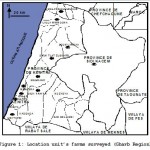 |
Figure 1: Location unit’s farms surveyed (Gharb Region).
|
The study was conducted in the following manner:
Collection and analysis of information on farms.
Determination of the coccidiosis prevalence: the research covered the period from July 2004 to August 2005 and was conducted in several localities in the Gharb namely: Kénitra, Fouarat, Sidi Taibi, Sidi Yahiya, Sidi Slimane, M’nasra, Dar Guedari and Sidi Kacem.
Diagnosis approach
The diagnosis was based on the use of a template that includes a number of elements and information.
The outline includes general data on livestock, food, clinical and lesion approaches (Table 1).
Table I: Diagnosis Information of Disease Pathology.
| General data on livestock |
§ date of visit § Area of collection § Livestock men. § The amount § Chick age. .. |
| General data on the food | § . Status of transport
§ Storage condition § Food § Total food consumed by topic § Consumption Index: consumption is defined as the ratio between the food weight consumed in the body weight of animals (IC = kg of food consumed / kg given).
|
| Clinical Approach | § Mortality
§ Clinical examination subjects patients: Autopsy § Litter: wet, presence of blood § General dominant signs § Growth § Check the temperature ,Ventilation § Average Weight (Scale of a representative sample %)
|
| Lesion Approach | § Digestive lesions.
§ Enteritis (Duodénum, Iléon, Jejunum, caecum and Rectum) § Kind of (congestive, catarrhal hemorrhagic, necrotic) § Type of ignition congestive catarrhal, hemorrhagic, necrotizing injury. .
Injury: Clinical + Autopsy = Suspicion
|
The approach is to identify farms suspects. A suspect livestock characterized by: poor condition of livestock, soft droppings and mortality.
An autopsy and lesion study was carried out to determine the species of Eimeria microscopically in diseased chickens from farms suspects.
Coccidiosis Diagnosis
The diagnosis of coccidiosis is based on:
– The injury after autopsy examination: 290 chickens were sampled for autopsy at the Laboratory of Biology and Health. A full autopsy is carried out to find lesion coccidiosis but also those of other diseases (necrotic enteritis).
After the autopsy, the intestine is considered charged under a binocular microscope.
The lining is scraped in various strategic locations and examined under a microscope slide between low and high magnification to diagnose different coccidiosis. Different methods can be used to differentiate between species of coccidian; cell marking lesion was used in our case. This method can determine the virulence and species of coccidian infection based on the damage to the internal organs, particularly lesions in the intestinal region (Johnson and Reid, 1970).
The establishment of injury score
Johnson & Reid (1970) have established lesion scores of 0 to 4 to assess the severity of infection coccidian. These scores are still used routinely to diagnose coccidiosis and to evaluate the effectiveness of anti-coccidian in infection control by coccidian and helps identify species of coccidian. The lesion marked, lesion scores and lesion points are a system which indicates the severity of the disease based on the degree of damage on each part of the intestine (Figure 2).
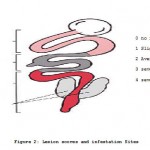 |
Figure 2: Lesion scores and infestation Sites.
|
Search for oocysts, fresh droppings were selected at random in different parts of the building in chickens of 4 week of age. The search for oocysts was made by the qualitative method advocated by Hamet et al., (1982). The Microscopic examination of raclages mucosa at different levels of the intestine was used to confirm or deny the presence of coccidian that could assist in the identification of species taking into account the location. The identified coccidians were preserved through a solution of potassium dichromate to 2%.
Results
This study focused on two components, the first was devoted analysis of the epidemiological situation of avian pathology (149 farms randomly selected), while the second was reserved for identify Eimeria species, protozoan responsible for coccidiosis in chicken, and to determining its prevalence.
The results of this study were based on surveys of 149 farming units in the study area, autopsy of 290 chickens, the establishment of lesion scores and detection of Eimeria.
Epidemiological situation of the avian disease in the region of Gharb
The analysis of the epidemiological situation of the diagnosed Livestock during the study period shows that the bacterial diseases were about 12.4%; viral infections (Gumboro = 4.27%, Pseudo avian influenza PPA = 4.43 %); Suspected cases (enteritis and coccidiosis) = 19.46% and healthy = 60%. within these 149 farms 19.45%. Coccidiosis is suspects and need confirmation.
Livestock Suspects
Among the 149 farms, 29 farm units had 19.45% coccidiosis conditions. These 29 farms were suspected cases. This suspicion was based on the symptoms of coccidiosis which requires an autopsy for a possible confirmation or to make the lesion method scores rated 2 to 4 according to Johnson and Reid (1970) Scale. In addition, what was observed on seasonal diseases; Figure 3 expresses the monthly rate of suspected cases. The broilers were parasites whatever the month or season (Figure 3).
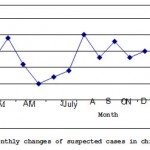 |
Figure 3: monthly changes of suspected cases in chicken.
|
On the critical period of onset of diarrhea (suspects) in the chicken meat falls between the 4th and 6th week with a percentage of 55.55%.
Coccidiosis
Epidemiology of coccidiosis parasitic chicken meat
The microscopic observations of oocysts and location of lesions and digestive tract droppings of 290 chickens examined had identified three species responsible for coccidiosis. These species were: Eimeria maxima, Eimeria necatri , and Eimeria tenella (Figure 4).
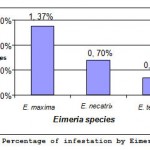 |
Figure4: Percentage of infestation by Eimeria.
|
On the other hand, we quantify the losses caused by this disease to 2% mortality and a fall in production of around 20%.The Consumer Index (CI) is defined as the ratio between the weight of food consumed in the body weight of animals (CI = kg of food consumed / kg given). During the current study, calculated CI was 2.06 in the case of E. maxima, 2.05 in the case of E. necatrix and 2.3 in the case of E. tenella (Table 2) (Hubbard, 2003).
Table 2: Influence of coccidiosis on the Consumption Index (present study).
Âge |
Mortality | Food consumption | Average weight |
Consumption Index |
||||
| (days) | (%) | Our | Standards* | Our | Standards* | Standards* | ||
| Parasite | study | study | Our study | |||||
|
|
||||||||
| E. maxima | 39 | 6,2 | 3450 | 3201 | 1670 | 1784 | 2,06 | 1,79 |
| E. necatrix | 28 | 4,7 | 1740 | 1709 | 850 | 1065 | 2,05 | 1,60 |
| E. tenella | 38 | 8,0 | 3654 | 3049 | 1590 | 1718 | 2,30 | 1,77 |
* The standards according to Hubbard (Hubbard, 2003).
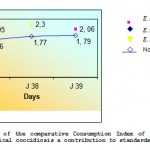 |
Figure5: Evolution of the comparative Consumption Index of livestock suffering from clinical coccidiosis a contribution to standards.
|
Discussion
The diagnosis epidemiology showed that most chickens whose organs have been collected and examined were apparently healthy (60%). However, cases of gumboro, PPP; colibacillosis have been recorded in birds autopsied respectively with percentages 4.27%, 4.43% and12.24%. The gumboro or infectious bursitis is regularly cited among enzooties affecting poultry, Courtecuisse et al. (1990) have reported a high prevalence of the gumboro disease (73.9%) in Tchad. This shows the endemic nature of this disease.
However, this disease has a negative impact on production. Indeed, it affects the immune system, thereby facilitating the installation of various diseases. In Niger, Courtecuisse et al. (1990) have reported a prevalence of 63% for the gumboro disease among unvaccinated chickens against 47% among vaccinated chickens. In Bangladesh, Abdul Ahad (2003) reported a high prevalence in different poultry production systems.
In this study, it was observed that mortality was significantly higher in most small flocks in rural areas compared to the commercial livestock in urban areas. This could be due to the conducted practice in a
commercial. The PPA is a highly contagious viral disease, transmitted very fast, with considerable economic importance and a very high mortality (up to 100%). It may be associated with bacterial complications. In Tunisia Nafti (2001) reported that the main avian diseases which caused significant losses in livestock were Pseudo Pestes Aviaire. The colibacillosis, whose main entrance way is the respiratory tract, causing injuries and events that may vary depending on the age of the animal and affects mainly chicken meat (Stordeur et al., 2002). It is responsible for major economic losses in the poultry and represents an important cause of seizure at the slaughter-house Elfadil et al. (1996). Thus, according to a study in slaughter-houses, 43% of carcasses seized because of illness showed lesions pericarditis, perihepathite and aerosacculite typical of the colibacillosis. The litter humidification cause diarrhea and fermentation releases the ammonia, and promotes the colibacillaires respiratory problems in poultry.
During our surveys, this disease was observed consecutively because of the livestock fault aggravated by the intervention of gumboro and the coccidiosis. It was a colisepticémy leading to sudden deaths after deduction, anorexia, in appetence and lameness.
The most sensitive birds were especially those whose nutritional status is low, or even those who were suffering from conditions such immuno-suppressive infection of the scholarship Fabricius (gumboro). The passage of gumboro resulted in a consumption of food and thereafter a dose insufficient anti-coccidien consumed, which leads the coccidioses in poultry (Courtecuisse et al., 1990). Suspected cases notified (coccidioses and enteritis) were observed in birds examined with a high percentage of 19.4%. Cases of diarrhea, may be linked either to the combined action of several species pathogens, or coccidiosis. The impact of these suspected cases on poultry was evidenced by the magnitude of problems and food-borne parasitic diseases, the resistance and anti-coccidials applied in the farms surveyed. Also, one can add the regulatory restrictions imposed on growth factors. The poor quality of drinking water explains the non-specific enteritis in chickens (Van Der Horst F, 2007). The critical period of the diarrhea (suspected cases) in the chicken flesh is in the period between 4 to 6 weeks (Figure 4). It may explain the strong diarrhoea during this period by stress related to the shutdown of heating, lack of control over ventilation and the consequences of technical errors applied by employees. The factors cited are clarified in Plate 1 indicating a barn poorly ventilated and poorly heated (Plate 1).
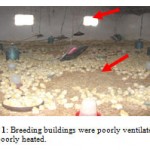 |
Plate 1: Breeding buildings were poorly ventilated and poorly heated.
|
The intercurrent coccidiosis disease promotes reducing the resistance of the host and reducing the consumption of food, thus ingesting the anti-coccidial. Based on the Long et al. (1968) research, the coccidiosis can cause anorexia and malabsorption of nutrients and can also reduce the availability of ARG and other amino acids (Allen & Fettererm, 2000; Ruff & Allen, 1990).The consequences of these infections in poultry are: achieving the overall condition; disruption of specific organs (respiratory, digestive, immune, declining performance; mortality that can reach 90 to 100% in case of PPA (Plates 2a and 2b).
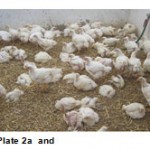 |
Plate 2a.
|
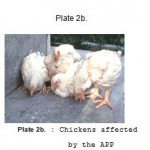 |
Plate 2b
|
The coccidian parasites are very common in poultry. The identification of Eimeria species is crucial to understanding the risk of coccidiosis. The difficulty of identifying these coccidia can not set a threshold beyond which there is a danger. Some coccidia are not pathogenic (e.g. E. præcox and E. mitis), others are very prolific but few pathogens (e.g. E. acervulina), or prolific and highly pathogenic (e.g. E. tenella), or shortly prolific and pathogens (e.g. E. necatrix) (Naciri, 2000). Some highly developed techniques using immunological markers for the detection of oocysts from specific chicken species that are potentially pathogenic. Thus, specific antigens of E. acervulina, E. tenella, E. maxima and E. necatrix (Reperant et al., 2000).
In Nigeria, Seven Eimeria species have been identified and described by Majaro (1981) in poultry.
During this work, parasitological examination of Eimeria species, showed that about 149 farming units prospecting during our study, 29 units are suspected. A total of 290 chickens were sampled at a rate of 10 subjects per unit suspected.
The location of lesions and the appearance of microscopic oocysts allowed to consider the involvement of different species coccidian confirmed by laboratory.
chickens infected with the Eimeria maxima with a prevalence of 1.37%.
chicken infested by the species Eimeria necatrix with a prevalence of 0.34%.
chickens infected by Eimeria tenella with a prevalence of 0.70%.
“Eimeria maxima”
The clinical approach subjects infested by Eimeria necatrix showed digestive signs particularly in the form of diarrhea (crotte with soft bedding) and general dominant signs namely inappetence and stunted with heterogeneity. The lesional approach after autopsies of dead and sick subjects showed lesions in the middle part of the intestine (Plates 3 and 4). It was bloody along the loop duodenum. The intestinal contents may contain mucus and a few small spots of blood (red blood cells which give a characteristic color (reddish brown) and rotten smell). Eimeria maxima, infects the intestine Middleweight (jejunum and the beginning of the ileum, part and on the other Meckel’s diverticulum), but back most often in the duodenum. It develops in epithelial cells in the small intestine and usually it causes a chronic intestinal coccidiosis. Most of these injuries occurred in the duodenum.
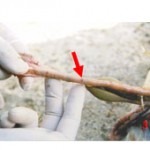 |
Plate 3: Petechiae red caused by E.maxima (middle part of the intestine).
|
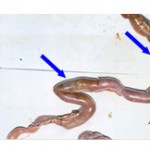 |
Plate 4: Intestine bloated due to E.maxima.
|
“Eimeria necatrix”
The clinical approach of infested subjects by E.necatrix shows digestive signs particularly in the form of diarrhea (litter very wet) and general signs dominant namely prostration; loss of appetite; manure spills and stunted. The approach lesional after autopsies of dead and sick subjects showed digestive lesions (Plates5 and 6).
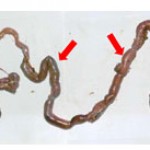 |
Plate 5: “Eimeria necatrix” Dark Intestine, slightly baloney”
|
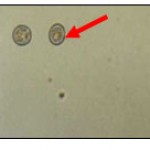 |
Plate 6: Oocyst of Eimeria necatrix after a week of infection (magnification X100).
|
“Eimeria tenella”
The clinical approach of infested subjects by E. tenella showed digestive signs particularly in the form of diarrhea (wet litter with blood) and general dominant signs, namely drowsiness, fatigue and in appetence with a stunting and heterogeneity. The lesion
approach after autopsies of dead and sick subjects showed haemorrhagic lesions at the level caecums with a score 4 (Plates 7 and 8). The bleeding and a central cluster, more or less hard, were formed by a significant accumulation of blood and desquamations of the mucosal surface. A loss of appetite, bloody diarrhoea, ruffian feathers. E. tenella caused damage and led to mortality (Plates 9 and 10).
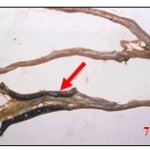 |
Plate 7: Deformation of coecum due to E.tenella.
|
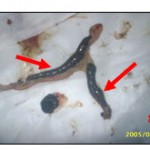 |
Plate 8: Content of caecums infested by E.tenella.
|
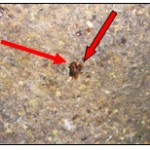 |
Plate 9: Fientes hemorrhagic.
|
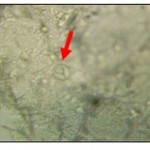 |
Plate 10: microscopic oocyst of E.tenella (X100).
|
In recent years, work on the use of food as an aid to control coccidiosis were dealt with by several teams after being abandoned with the introduction and development of anti-coccidial. The feeding may also intervene by its constituents and by the mode of presentation, either directly on the parasite.s development or by reinforcing the host defences or by leading to the healing (Gabriel & Naciri, 2001). The clinical intestinal coccidiosis are characterized by a loss of appetite, low livestock performance (slower growth see weight loss), diarrhoea whose importance varies with the degree of infestation. On the production we observed
the increase in CI, heterogeneity of lots, development of pathogenic contaminants in the digestive flora.
In France, the conducted studies by Reperant et al. (2003) have identified seven species of Eimeria: E.
acervulina, E. Brunetti, E. maxima, E. mitis, E. necatrix, E. praecox and E. tenella. Two of them are
not pathogen: E. mitis and E. praecox, and two lead morbidity and mortality: E. necatrix and E. tenella.
According to the same authors, the other three species have the adverse effects on livestock performance of birds, and can sometimes cause symptoms: diarrhea, nervousness, prostration.
Our results showed that the average weight of chickens differs significantly between the affected farms
and unscathed farms. The clinical losses fades gradually in a few weeks; 215 grams represent 20% of normal weight; one can say that the most serious cases of intestinal coccidiosis are caused by E. necatrix. The clinical coccidiosis kill 2% of the sample. They fall production by 20%.
In normal conditions of livestock, the index value of consumption is between 1.9 and 2.1, an average value of 2. The value 2 indicates that the chicken consumed2 kg to food to produce 1 kg body weight. In case the index value of consumption is higher than the standard value, we must look for the causes by prioritizing: waste of food, quality of the food, poussin smudged, quantity and quality of water, and a high mortality rate(Azeroul, 2007). The higher consumpton index is the development of pathology in the host. E. tenella becomes noticeable three days after infection. During a study conducted in Burkina (Palo, 1987), no significant difference was observed against by the consumption index in infected poultry by E. tenella.
The coccidiosis were charac-terized by the ingest reduction, an increase of the consumption index, a
modification of emplument, a decrease of the coloration of carcasses, diarrhea or blood in the feces. This disease,widely associated with the destruction of the intestinal epithelium, is responsible for reducing the absorption of nutrients in the case of coccidian affecting the small intestine or cause bleeding which can be fatal in the case of hard infection by E. necatrix or caecale species E. tenella [16]. The economic cost of coccidiosis is important. For example, in the United Kingdom, the annual losses were about £38.6 million, 98% were attributable to the rearing of chicken, which meant 4.5% loss of income from the poultry industry (Williams, 1999).
Conclusion
Due to the altitude of the region of the Gharb, the conditions of intensive raising are especially favourable. In general, the intestinal coccidiosis causes more falls of weight while the coccidiosis caecale causes more mortality. It is a question of balance: coccidiosis – Immunity – anticoccidian. These digestive pathologies are more and more difficult to manage by the breeders. The mastery of the litter becomes delicate because of dysfunction of the digestive activity demonstrated by the diarrhea at the chickens.It seems possible to improve the digestive situation by zootechnic solutions and notably by the sanitary precaution hold upstream. A particular attention has been brought to the quality of water that can be a source of digestive unrests. It is good to assure a mastery perfection of the conduct of raisings; quality management of water, management of the distribution of the birds. The vaccines are again of uncertain use and the new substances will become rare. It is therefore indispensable to keep the maximum efficiency of the present products and, in particular, to keep the products different of the ionophores that permit to change in chemical family and to use programs of rotation or shuttle to avoid the problem of resistance. It is therefore important to think in advance on the program of biosecurity and vaccination in order to avoid the consequences of illnesses current of the chicken, notably: the PPA, the respiratory infections due to the mycoplasmas, the illness of gumboro, the colibacillose and in a large measures the parasitic illnesses the coccidiosis.
It is evident from the presented results that the illness of the coccidiosis constitutes a real economic threat for aviculture in the region of the Gharb in Morocco.
References
- Abdul Ahad (2003) Isolation et caractérisations pathogéniques d’un isolat d’IBDV issu d’une épizootie de la maladie de Gumboro dans une unité avicole semi-intensive au Bangladesh. Bulletin RIDAF Vol. 13, No 1:6-9.
- Allen P. C. and R. H. Fetterer (2000) Effect of Eimeria acervulina Infections on Plasma L-Arginine. Poultry Science 79:1414–1417.
- Azeroul E (2007) Elevage de poulet de chair. Aviculture au Maroc.
- Courtecuisse C, Japiot F, Bloch N & Diallo I (1990) Enquête sérologique sur les maladies de Newcastle et de Gumboro, la pasteurellose et la pullorose chez des poulets de race locale au Niger. Revue ة Méd. vét. Pays trop 43 : 27-29.
- Elfadil A.A, Vaillancourt J.P., Meek A.H., Julian R.J., Gyles C.L (1996) Description of cellulitis lesions and associations between cellulitis and other categories of condemnation. Avian Dis : 40, 90-698.
- Fisa (2007) Fédération Interprofessionnelle du Secteur Avicole. Secteur avicole au Maroc. Site web: fisa.org.ma/
- Gabriel C, Naciri M(2001) Effet de l’alimentation sur les coccidioses chez le poulet .INRA Prod .Anim :14 ,231- 246.
- Hamet, N., Josse, J., Robin, B., Toucas, L (1982) Enquête épidémiologique sur la coccidiose du poulet de chair. Rev. Alim. An ; 21-30.
- Hassouni T, Belghyti D (2006), Distribution of gastrointestinal helminths in chicken farms in the Gharb region-Morocco. Parasitol Res 99:181-183.
- Hubbard (2003) Guide d’élevage,
- Idi I. Maikano Et H. Adamou (1998) Séroprévalence des maladies de Newcastle et de Gumboro chez des poulets locaux commercialisés à Niamey, Niger. Article édité par E.F. Guèye. http://www.fao.org/docrep.
- Johnson J, Reid W.M (1970) Anticoccidial drugs : lesion scoring technics in battery and floorpen experiments with chickens. Parasitol 28:30-36.
- Long P. L. (1968) The pathogenic effects of Eimeria praecox and Eimeria acervulina in the chicken Parasitology 58:691-700.
- Majaro, O.M (1981) Oocystes de coccidies chez les poulets de chair au Nigeria. Revue d’élevage et de médecine vétérinaire des pays tropicaux, 23-25p.
- Naciri M (2000) Coccidioses du poulet. INRA – Bayer. Edition Bayer Pharma Santé Animale, Puteaux France ; 12.
- Nafti (2001) L’aviculture tunisienne : situation, défficulté et perspectives. CIHEAM. Option mediterraneenes .Set .A/No 7 .1990.
- Palo, P.E (1987) La coccidiose du poulet de chair au Burkina. I. Pathogénicité de l’infection expérimentale à Eimeria tenella. Revue d’élevage et de médecine vétérinaire des pays tropicaux. 253-258.
- Reperant Jean-Michel, Ribot Julie, Thomas-Henaff Martine, Morel Henri, Morel Jeannine, Jestin Véronique (2003) Marqueurs immunologiques d’espèces de coccidies parasites du poulet. Cinquièmes Journées de la Recherche Avicole, Tours, 26 et 27 mars 2003.
- Ruff, M. D., And P. C. Allen (1990), Pathophysiology. in: Coccidiosis of Man and Domestic Animals. L: 263-280.
- Stordeur P, Mainil J (2002) La colibacillose aviaire. Ann. Méd. Vét 146 :11-18.
- Van Der Horst F, (2007). Les bonnes pratiques pour une eau de qualité en élevage de volailles label .Revue techniques et marchés avicoles (TeMA) 2007 numero 3 :12-16.
- Williams R.B (1999) a compartmentalised model for the estimation of the cost of coccidiosis to the world’s chicken production industry. J. Parasitol 21: 1209-1229.

This work is licensed under a Creative Commons Attribution 4.0 International License.





